The footpath, worn into sand the color of graham crackers, led over low, grass-stippled dunes to the beach on Lake Superior. A violent squall had rocked our little cottage in the dead of night, but now, beneath a sky so blue it hurt, the big lake was in a happy mood. A soft breeze, not quite warm but not cold, either, pulsed from the west; what surf there was, fizzing lightly in its ebb-and-flow against the cobbled shore, seemed as calmly imperturbable as the breathing of a sleeping god.
I plunked myself down on a driftwood log, pressed my hands into the cool sand, and leaned back. My ten-year-old granddaughter, Aubrey, has observed that I spend a lot of time “spacing out.” As an expert, then, I’m qualified to state that there are few better places to do it than a beach on Lake Superior, where you can spend hours gazing at that illimitable sweep of water and sky, ruminate on this, that, and the other thing, and imagine you are thinking Deep Thoughts.
At some point a flicker of movement impinged on my consciousness. Roused from whatever reverie I’d been indulging in, I saw that a small bird, of the basic shorebird type, was pecking its way along the water’s edge. It would scurry ahead very purposefully, stop to jab at some tiny morsel, then scurry ahead again, zigging and zagging as if connecting invisible dots. There was something almost comical in the briskly serious way it went about its business—like a child imitating a general—and yet there was something enchanting about it, too. I watched with a growing sense of delight; it was as if a nature documentary had been prepared for my benefit.
I was so absorbed in the show, in fact, that I didn’t really look at the bird, in the sense of trying to ID it, or even ponder what that identity might be. (I’d left my binoculars in the cottage.) Only when it had faded from sight did it hit me, in a kind of OMG moment, that it had to have been a piping plover—a federal endangered species that is among the most imperiled breeding birds in the upper Great Lakes.
I was aware that piping plovers nest in the area—there are signs posted by the Fish and Wildlife Service warning beach-goers to tread with care and in particular to keep their dogs leashed—but it had never occurred to me that I might actually see one. While the bird was on my radar as a reasonably well-informed citizen, the picture I’d formed was of a species so desperately rare, and so averse to human intrusion, that a casual sighting was a virtual impossibility. Serious birders armed with spotting scopes and up-to-the-minute intel see piping plovers, not random seniors spacing out on the beach.
Once we knew they were there, we began looking for them in earnest, “we” being Aubrey, in whom I’ve worked very hard to inculcate a love of nature, her grandmother Joan, and me. We saw them every day, if not every time we visited the beach, and for reasons of her own Aubrey took to calling them “clovers.” She enjoyed watching them, both with and without binoculars, frequently exclaiming “They’re so cute!”
I tried to impress on her how incredibly fortunate we were to be able to see piping plovers, also to impart a little of the species’ amazing natural history. Among the first migratory birds to arrive in the spring and also the first to depart in late-summer, their habitat on the Great Lakes is low, treeless, sand-and-cobblestone beaches. Their nest is a mere depression in the sand, where the female lays four speckled-buff eggs that are easy to mistake for ovoid stones. While this makes them hard for predators to detect, it puts them at risk for being inadvertently trampled by human traffic.
And that, needless to say, is the bottom-line reason the species is struggling to hang on: human encroachment on its fragile, highly specialized habitat.
Its only armor, really, is its near invisibility. Against the muted tones of the shorelines it has evolved to inhabit, the piping plover appears evanescent, as if endowed with the ability to materialize and de-materialize at will. There were times, during our week at the beach, when a plover that we had no idea was there would suddenly take shape only 20 feet away; other times we would be watching one, our gaze would wander for a moment, and when we looked back it might take several seconds to find it again—if we could find it all.
Snowy white below with a dusting of palest gray on its back, the piping plover is a pear-shaped powder-puff balanced on orange toothpick legs. Its black-tipped orange bill is stout as a roofing nail; its inscrutably dark, unblinking eyes give it the expression of something that hatched in Geppetto’s workshop. It wears a black collar, open at the throat, while another black band, called a “crown stripe,” runs laterally across its forehead.
Aubrey was right: The piping plover is cute—adorably so. A more grown-up description might be “exquisite,” or “charming,” or “whimsical.” But as the days passed, and as I found myself falling under the spell of these beguiling little birds, I began to perceive how mighty they are, how tenaciously heroic. To occupy the terribly small, exposed niche that they do, and to survive in the face of odds that are only growing longer as the planet warms, the weather grows more extreme, and the human population explodes … It all but brought me to my knees.
Quite naturally, I began to feel protective of “our” plovers. Every gull was a threat, every crow a clear and present danger. People walking the beach, especially those with dogs, became objects of teeth-gritting resentment. I wondered if we should even visit the beach ourselves, fearful that our presence might cause the birds additional stress and possibly increase their exposure to predators.
I’d become a textbook example of what Aldo Leopold was talking about when he wrote “One of the penalties of an ecological education is that one lives alone in a world of wounds.” Joan, as spouses will, picked up on this. Sitting on the beach at twilight, the sun melting into Lake Superior like a fire going out, she said “You’re worried about the plovers, aren’t you?”
“I can’t help it,” I said. “I know too much.”
Aubrey had been digging in the sand while Joan and I watched the sunset, and the intensity of her efforts suggested she was on a mission. I walked over and saw that she had scooped out a trough leading to a little cave-like hollow, which she was still in the process of excavating.
“I’m making a hideout for the clovers,” she explained. “They can go into it at night and be safe.”
“That’s a wonderful idea,” I said. “I’m sure the clovers will appreciate that.”
Oh, for the can-do attitude of a ten-year-old! You perceive a need, and you do something about it. If it were only that simple …
Now, back home, my evanescent heroes remain close in thought. I see them in my mind’s eye, scurrying along the beach with those quick, decisive movements, making their stand at the margins of immensity.




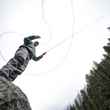

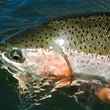
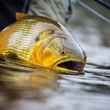



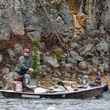
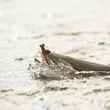



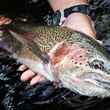
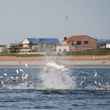








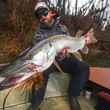



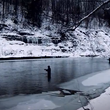
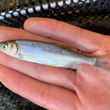
Comments